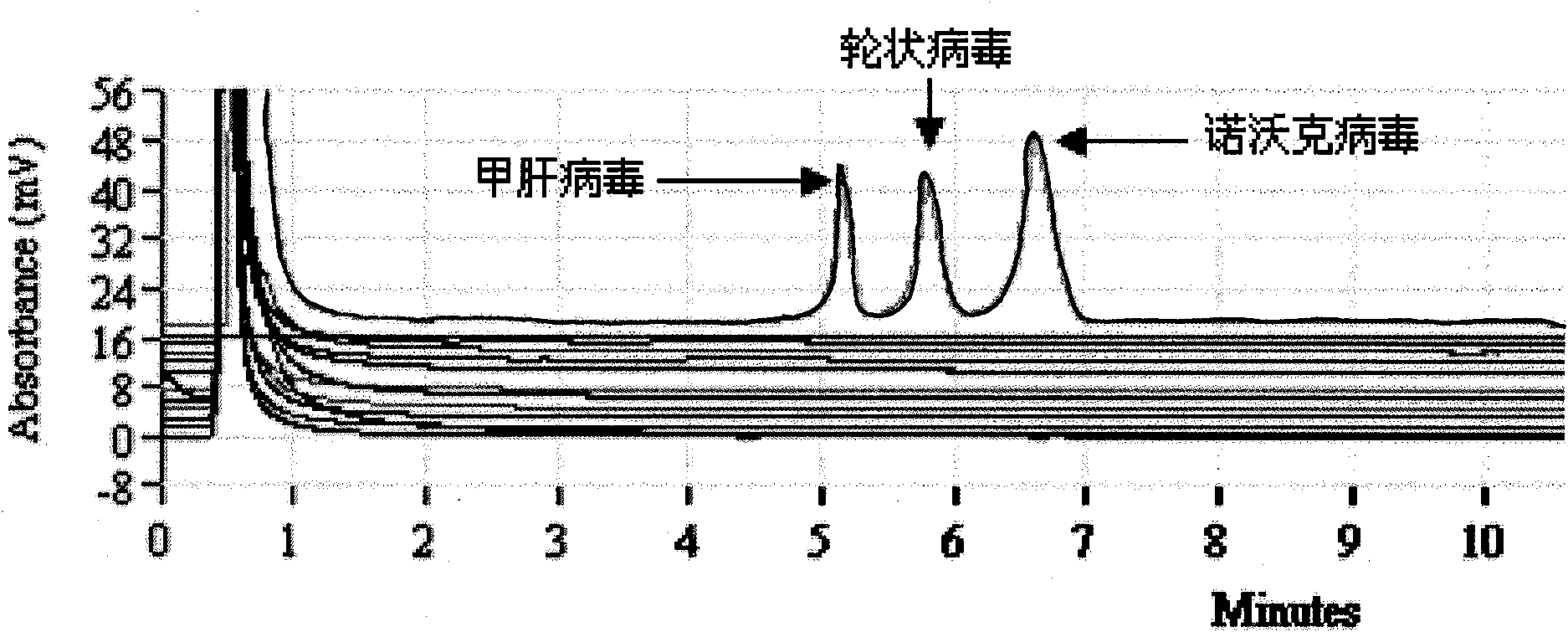Detection kit and detection method for 3 species of food-borne viruses in marine products
A virus detection and kit technology, applied in the field of detection, can solve the problems of false positives, lack of high throughput, identification of one or a few bacteria, etc., and achieve the effect of high throughput detection and high detection sensitivity
- Summary
- Abstract
- Description
- Claims
- Application Information
AI Technical Summary
Problems solved by technology
Method used
Image
Examples
Embodiment 1
[0042] Embodiment 1, the establishment of 3 kinds of foodborne virus detection kits and detection methods in aquatic products
[0043] (1) Establishment of the kit
[0044] The primers determined in this embodiment for detection are shown in the table below:
[0045]
[0046]
[0047] On this basis, three foodborne virus detection kits in aquatic products were designed for PCR amplification:
[0048] The kit includes reverse transcription-Tag DNA polymerase at a concentration of 5U / μL, reverse transcriptase at a concentration of 5U / μL, and RT-PCR reaction solution; the RT-PCR reaction solution contains 10mM Tris·HCl, 50mM KCl, 25mM MgCl 2 10 mM each of dNTP (dATP, dGTP, dCTP and dTTP), 40 U / μL of RNase inhibitor, and 20 μM each of the upstream and downstream primer pairs of the above three foodborne viruses;
[0049] Storage conditions of the kit: -20°C.
[0050] The mPCR-DHPLC method of using this kit to detect 3 kinds of foodborne viruses in aquatic product samples i...
Embodiment 2
[0078] Embodiment 2, specificity test
[0079] A variety of food virus standard substances were used to simulate the operation steps of daily inspection, and nucleic acid was extracted according to the method established in Example 1, and mPCR-DHPLC detection was performed.
[0080] The RNA of hepatitis A virus, Norwalk virus and rotavirus were extracted respectively, and the DNA of poliovirus (I, II, III, vaccine strain) and Coxsackie virus (type 1-6, vaccine strain) DNA, Pseudorabies virus DNA and hepatitis B virus DNA, and sterilized water as blank control. Using the specific primers of three viruses, the extracted template was amplified according to the method established in Example 1, and mPCR-DHPLC specificity test was carried out. The test results are attached figure 1 shown.
[0081] The results of the specificity test show that the detection kit and detection method established in the embodiment can specifically detect three target viruses, only hepatitis A virus,...
Embodiment 3
[0086] Embodiment 3, multiplex PCR-DHPLC sensitivity test
[0087] With the food virus standard substance of known virus amount, the kit and detection method established in Example 1 were used to make a template and mPCR-DHPLC detection to determine the sensitivity of detection. Table 1 shows the genomic nucleic acid fragments extracted from the three viruses at different inoculation amounts, the OD value was measured by a spectrophotometer, and the nucleic acid content was calculated.
[0088] In order to verify the detection limit of this detection method, the concentration of the positive plasmid pMD18-T (respectively containing the target sequences of hepatitis A virus, Norwalk virus and rotavirus) was measured with a spectrophotometer, and then diluted to 1×10 -1 ng, 1×10 -2 ng, 1×10 -3 ng, 1×10 -4 ng, 1×10 -5 ng, 1×10 -6 ng, 1×10 -7 ng, 1×10 -8 ng, extract plasmid DNA according to the method of Example 1, and perform mPCR-DHPLC detection. The following table (tab...
PUM
 Login to View More
Login to View More Abstract
Description
Claims
Application Information
 Login to View More
Login to View More - R&D
- Intellectual Property
- Life Sciences
- Materials
- Tech Scout
- Unparalleled Data Quality
- Higher Quality Content
- 60% Fewer Hallucinations
Browse by: Latest US Patents, China's latest patents, Technical Efficacy Thesaurus, Application Domain, Technology Topic, Popular Technical Reports.
© 2025 PatSnap. All rights reserved.Legal|Privacy policy|Modern Slavery Act Transparency Statement|Sitemap|About US| Contact US: help@patsnap.com



